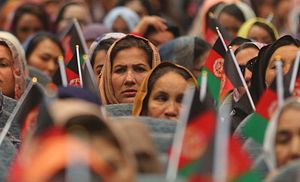For nearly a year, Washington and the Taliban were engaged in peace talks and had even reached a tentative agreement. In mid-September U.S. President Donald Trump abruptly ended those negotiations. Today, it is unclear if the year-long dialogue will be salvaged. What does remain certain is that U.S. leadership is still needed for long-term sustainable peace.
A rash withdrawal will put Afghan women and girls at risk of losing hard won freedoms, and without support from the United States and its allies, Afghanistan could once again become a safe haven for terrorism.
Ideological competitors like China and Russia will gladly fill any void, as seen in places like Myanmar, Syria, and Ukraine. These authoritarian regimes are more likely to exploit Afghanistan’s resources and geopolitical value than invest in the rights of Afghans, particularly women and girls, or good governance. They are also more likely to allow conditions in Afghanistan that expand operating space for terrorist networks.
To be clear, we are not advocating for a perpetual U.S. military presence. The Afghan people should and will control their future, but at this crucial time during the country’s nascent journey toward freedom, U.S. support is still necessary.
First, the United States and its allies must continue its financial assistance and training support of the Afghan National Defense and Security Forces (ANDSF), the Afghan military and police. Should the United States fail to lead and abruptly pull away, history could very-well repeat itself. In the wake of the Soviet departure in 1989, factionalism, the Afghan government’s crisis of legitimacy, and the dissolution of the Afghan army and police led to a descent into civil war that massively harmed Afghan women. Without stability, Afghanistan is likely to become a haven for violent extremism once again; after all, the Islamic State-Khorasan Province is still a threat, and the Haqqani network is stronger than ever.
Furthermore, the United States and its international allies must continue providing foreign aid. According to the World Bank, foreign assistance in Afghanistan will be needed until 2030. These resources are used on stability-boosting efforts with both public- and private-sector engagement which help undermine extremist narratives.
A drastic reduction of foreign assistance means basic services such as access to public health care are in jeopardy of falling by the wayside. A stable and peaceful Afghanistan requires equal access to justice; respect for human rights; effective rule of law and good governance; transparent, effective, and accountable institutions; and access to quality education.
Since the fall of the Taliban, tremendous progress has been made. Millions of girls are attending school and women have greater access to health care, and are voting, running for office, starting businesses, and entering the workforce.
But the Taliban must commit to a permanent ceasefire and ongoing violence must stop. They have consistently perpetrated brutal attacks against the Afghan government, security forces, and civilian populations, even while peace talks were ongoing.
Sadly, despite these gains, women and girls have borne the heaviest burden of the Taliban’s violence – they have been killed in significant numbers; insecurity has restricted their access to education and health care; and they suffer disproportionately from conflict-related displacement, economic insecurity, and lack of access to essential services.
If the Taliban cannot stop threatening innocent Afghans, then their commitment to peace is not serious. However, this should not discourage Washington from working with the Afghan people and government to create a roadmap to peace.
Intra-Afghan talks between Kabul and the Taliban need to be the starting point, and the United States should enable an environment that is transparent and inclusive, particularly of women, for those discussions. Such talks should include the United States and propose a framework for the gradual drawdown of remaining U.S. and coalition forces based on conditions on the ground. Additionally, the United States and other development partners should continue buttressing Afghanistan’s efforts to spur economic growth, strengthen civic institutions, and build national unity.
Given the Taliban’s track record on human rights, and similar views shared by other insurgent organizations, Afghans, particularly Afghan women, rightfully fear a return to an era of invisibility and dehumanization. That is why the Taliban must also accept several realities within the context of intra-Afghan talks that should be tied to the drawdown of U.S. and coalition forces, namely: Afghanistan is now a democracy; Afghanistan is a pluralistic society that protects the rights of men and women, and is open to diverse political viewpoints; policy is made through political solutions, not imposed through violence, fear, or intimidation.
Washington must ensure that women are active participants in these conversations, and, ultimately, an integral party of any mechanisms that monitor and verify the implementation of a peace agreement. They should continue leading an international coalition that remains steadfast in its support of Afghanistan and encourages long-term peace.
Farhat Popal is a senior program manager at the George W. Bush Institute Women’s Initiative.
Chris Walsh is a senior program manager at the Bush Institute Human Freedom and Women’s Initiative.

































